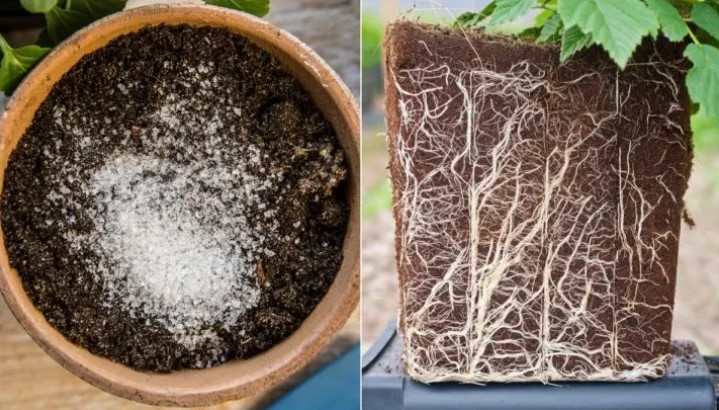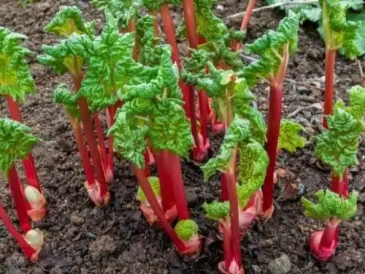Have you noticed how we’ve become obsessed with microbiomes over the past decade?
Whether it’s the one residing in our gut or the one that’s below our feet, microbiome studies seem to be popping up everywhere. And with good reason, the more we learn about them, the more we see how important these microscopic communities are to keeping our plants or us healthy.
If you love gardening, you already know this is true. As many a seasoned gardener will tell you, it’s all about the dirt for healthy plants.

Most of the important processes that lead to healthy plants happen out of sight down underground. In fact, all that feeding and fertilizing we do has more to do with replenishing nutrients in the soil.
I want to look at one of the cooler parts of the soil microbiome and show you how to put it to work in your garden.
Let’s talk about mycorrhizae.

There are microscopic naturally occurring fungi in most soil that form a symbiotic relationship with the plants growing around them. In established forests, this network of fungi can span miles, taking years to grow.
If you’ve ever heard about trees “talking to each other ,” this underground network is how they do it. These massive pathways connect plants to one another underground.

Okay, well, that’s all very interesting, Tracey, but what does that have to do with my garden?
A lot. Read on, my friend, learn more about what mycorrhizae are, how they can benefit your garden, what way to use them and how to choose one.
What exactly are mycorrhizae?
The word mycorrhizae means fungus root. Myco means fungus, and rhyzo means root.
They’re naturally occurring fungi that inhabit the soil forming a symbiotic relationship with the plants all around them. These microscopic fungi attach themselves to plant roots, or sometimes permeate the roots, and become a part of the root system itself.
Now I know what you’re thinking; this sounds more parasitic than symbiotic. But trust me, this little underground relationship is good for both the fungi doing the attaching and the plants whose roots now have roommates. The presence of the fungi means a ton of benefits for plants, which we’ll get to in a bit.
There are two types of mycorrhizae – ectomycorrhizae and endomycorrhizae.
The ectomycorrhizae are the ones that form colonies on the outside of plant roots. It’s these types that make up those amazing networks between trees, as they prefer to cozy up mostly with trees.
The second type, endomycorrhizae is what we’ll focus on as these little fungi are the most prevalent. Not to mention, they’re the kind that most garden plants prefer to have growing in the ground with them, so they’re most often the strains of fungi used in commercial mycorrhizae.

As I mentioned, these fungi actually permeate the roots and become a part of the plant’s root structure. If you’re a plant, this is a very good thing as it significantly increases the surface area of the root system. And by significantly, I mean hundreds of times bigger.
Okay, so what does that mean for the plant?
I’m so glad you asked! Let’s dive into the benefits of adding mycorrhizae to your soil. We’ll start with this increased root system.
3 Ways Mycorrhizae Benefit Plants
1. Less Frequent Waterings and More Drought Resistant Plants
Imagine drinking a glass of lemonade on a hot day with a straw. Now imagine you put six more straws in your lemonade and sipped from them all at once. You’d quench your thirst much faster, and you would also need to take fewer sips to feel satisfied. It’s the same for a plant that has a much larger root system.
Because the root system is larger, it can access more water in the soil, meaning the plants don’t need to be watered as often.
At the same time, this makes plants more resistant to drought. For you folks in drought-prone areas, you’re going to want to experiment with adding mycorrhizae to your soil.
2. Prevents Soil Erosion
Again, because the root system has so much surface area, it really gives your plant some grab. Large root systems keep soil in place. And more importantly, nutrients – all these tiny little filaments in the soil hold onto nutrients so they can be accessed later by the plants as they need them.
3. Fungi Make Nutrients Available
These tiny little fungi release enzymes into the soil, which help free up and break down nutrients, making them easier for the plants to access nutrients when they need them most.
I Thought You Said This Was a Symbiotic Relationship? It Sounds Like the Plants are the Only Benefactor.
Nope. The fungi integrate themselves within the root system of the plant to receive food. As the plants grow, they pass sugars (carbohydrates) down into their roots which the mycorrhizae feed. It truly is a win-win for both plants and fungi.
What You Can Expect to See in Your Garden
There have been numerous studies done and more underway extolling the benefits of using mycorrhizae in the garden. The benefits are so great that many commercial nurseries use them to bring larger, healthier plants to market, and the farming industry is using mycorrhizae to increase their yields while lowering the cost of fertilizing.
If you inoculate your soil, you can expect:
- Heartier, more drought-resistant plants
- The need for less frequent watering
- Larger plants with greater yields – more food and bigger blossoms
- Greater disease and pest-resistance
- Improved soil health

Honestly, it’s easier to tell you which plants won’t benefit. Plants in the brassica family generally don’t partner up with these beneficial fungi—broccoli, cabbage, cauliflower, Brussels sprouts, etc.
Even though brassicas don’t benefit from the addition of mycorrhizae, they also won’t be harmed by them either. So, if you’re inoculating nearby plants, have no fear.
Beyond the brassicas (sounds like a cheesy romance novel), nearly all of your typical garden vegetables will partner up with mycorrhizae added to the soil.
Wait, I Grow My Garden in the Ground, Don’t I Already Have Mycorrhizae?
That’s a big maybe.
You probably have some sort of fungal relationship happening in your soil naturally. However, whenever you till or dig your garden, the natural hyphae (these are the individual filaments that make up a mycorrhizal network) present in your soil are damaged.

Remember, these networks take years to establish; if you’re rototilling or digging, you’re destroying them.
Also, if you use synthetic fertilizers, you most likely have a damaged soil microbiome. Fungi specifically do not do well in the presence of synthetic fertilizers.
If you want to begin healing the natural network of fungi in your garden soil, you can start by switching to the no-dig garden method . And, of course, you can replenish your soil by inoculating it and getting those fungi growing again.
Container Gardening

However, if you’re inoculating your potting mix with mycorrhizae, you’ll be growing plants that are more efficient at taking up water. And of course, don’t forget the bonus of a bigger yield.
When you grow with a pre-bagged potting mix, you’re getting soil that doesn’t have much going on. It’s been sterilized so it won’t grow nasty things while it sits in your local garden center waiting for you to buy it. Sure, many of these potting mixes have fertilizers added back in, but you’re still missing out on the natural microbiome that plants grown in the ground enjoy.

Houseplants

Don’t let your garden get all the goodies. Many houseplants will happily pair up with mycorrhizae as well.
For most of us, this means inoculating established plants. If you wish to get your houseplants in on the fungi benefits, be sure to choose a mycorrhizae formula that can be watered directly into the soil.
Even with a water-soluble formula, you’ll still want to get it as close to the roots of your houseplants as possible. For this, I suggest using a turkey baster. I recently inoculated all of my houseplants this way.
It was quite easy to do, and I was able to apply the inoculated water right at the roots of all of my favorite houseplants.

Get ready for a monster monstera!
So, Mycorrhizae is Just Another Fertilizer?
No, this is a common misconception. Mycorrhizae don’t fertilize the soil, but they make the existing nutrients in the soil easier for the plants to access. You will still need to fertilize your soil by adding compost, compost tea, fish emulsion or worm castings .
Nutrients can get tied up in the soil as they break down; however, mycorrhizae take the nutrients from these natural fertilizers and break them down, so your plants have access to them more readily.
As I mentioned above, using synthetic fertilizers can kill off your fungi, so avoid them at all costs.
Okay, I’m Sold; Now What?
First, you need to figure out how you’ll be using mycorrhizae.
The easiest way to use it is before you begin planting. You can mix it directly with the soil for containers or add it to the holes you’ll be planting seeds or seedlings. For this, choose a granulated inoculum or one that doesn’t need to be mixed with water and follow the packaging directions

You can also inoculate seedlings by dipping them into the reconstituted inoculum right before you plant them.




